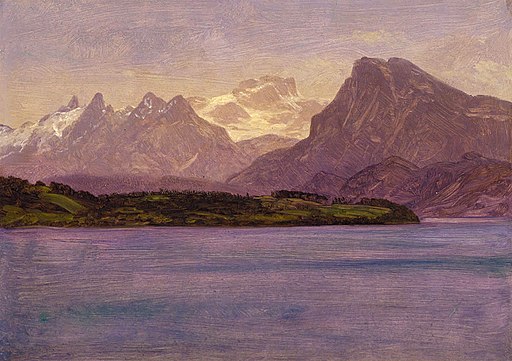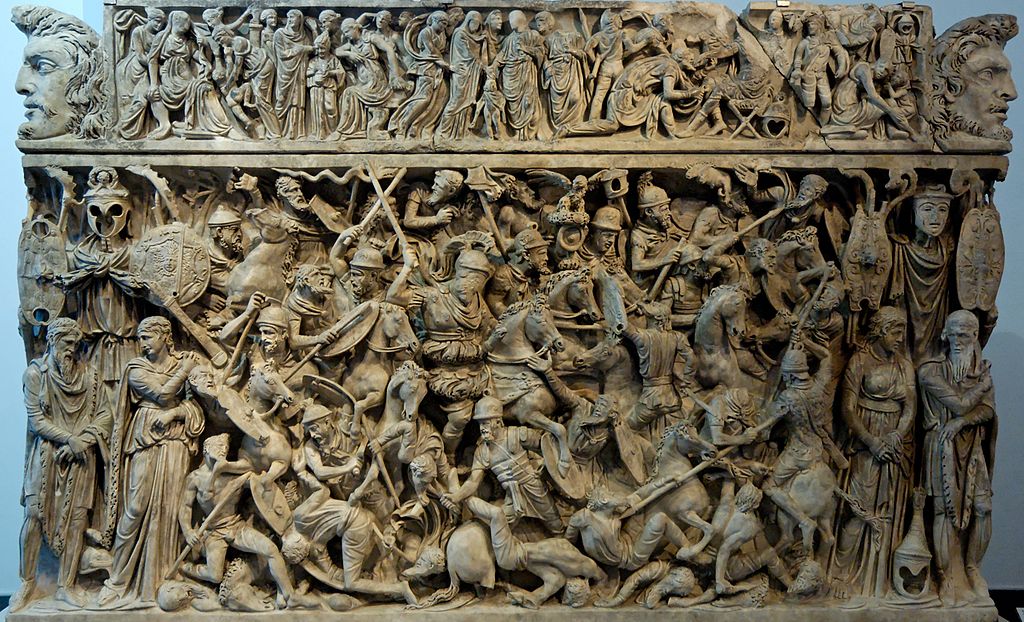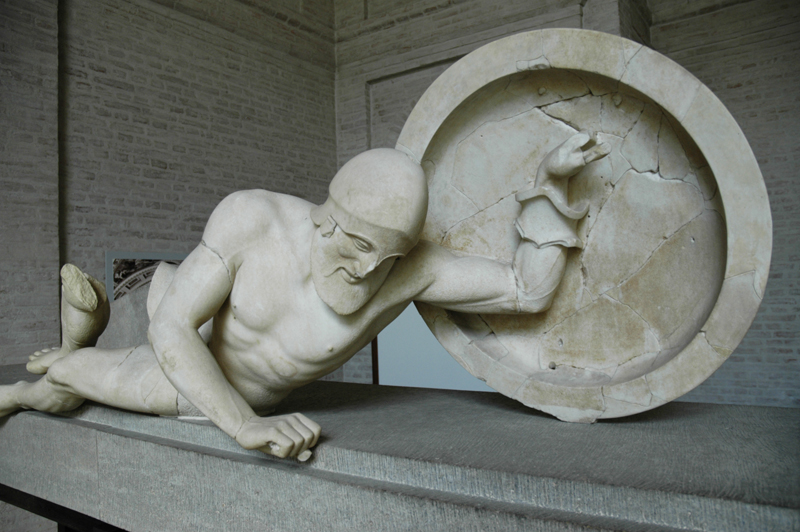
Albert Bierstadt was not the first artist to record the sweeping landscapes of the American West, but he was the foremost painter of them in the latter half of the 19th century.
Our Tour of American Landscapes by Albert Bierstadt include:
- “The Rocky Mountains, Lander’s Peak” by Albert Bierstadt – Metropolitan Museum of Art
- “North Fork of the Platte Nebraska” by Albert Bierstadt – Gilcrease Museum, Tulsa
- “Looking Down Yosemite Valley, California” by Albert Bierstadt – Birmingham Museum of Art
- “Alaskan Coastal Range” by Albert Bierstadt – Smithsonian American Art Museum
- “The Falls of St. Anthony” by Albert Bierstadt – Thyssen-Bornemisza Museum, Madrid
“The Rocky Mountains, Lander’s Peak” by Albert Bierstadt
“The Rocky Mountains, Lander’s Peak” by Albert Bierstadt is based on sketches made during Bierstadt’s travels in 1859. The painting shows Lander’s Peak in the Wind River Range of the Rocky Mountains, with an encampment of Native Americans in the foreground.
In the foreground of the painting, Bierstadt paints a band of Shoshone Native peoples. Bierstadt depicts the Shoshone people along with the majestic peaks. Bierstadt’s focus was on the relationship of the people with the landscape.
The Shoshone are a Native American tribe, which originated in the western Great Basin and spread north and east into present-day Idaho and Wyoming.
As more European-American settlers migrated west, tensions rose with the indigenous people over competition for territory and resources. Wars occurred throughout the second half of the 19th century.
The Rocky Mountains, Lander’s Peak
- Title: The Rocky Mountains, Lander’s Peak
- Artist: Albert Bierstadt
- Year: 1863
- Medium: Oil on canvas
- Dimensions Height: 186.7 cm (73.5 in); Width: 306.7 cm (10 ft)
- Movement: Hudson River School
- Museum: Metropolitan Museum of Art
~~~
“North Fork of the Platte Nebraska” by Albert Bierstadt

“North Fork of the Platte Nebraska”
“North Fork of the Platte Nebraska” by Albert Bierstadt reflected the idea of Manifest Destiny, where the west represented natural beauty, and the rivers served both obstacles and transportation routes to westward expansion.
The Platte River is a major river in the State of Nebraska. The Platte River is a tributary of the Missouri River, which itself is a tributary of the Mississippi River, which flows to the Gulf of Mexico.
The Platte over most of its length is a broad, shallow, meandering stream with a sandy bottom and many islands.
The river valley played an essential role in the westward expansion of the United States, providing the route for several major emigrant trails, including the Oregon, California, Mormon, and Bozeman trails.
The first Europeans to see the Platte were French explorers and fur trappers in 1714. They first called it the Nebraskier (Nebraska), a transliteration of the name given by the Otoe people, meaning “flat water.”
This expression is very close to the French words “rivière plate” (“flat river”), the probable origin of the name Platte River.
North Fork of the Platte Nebraska
- Title: North Fork of the Platte Nebraska
- Artist: Albert Bierstadt
- Year: 1863
- Medium: Oil on canvas
- Dimensions 18 1/8 × 20 1/8 × 2 1/2 in de(46 × 51.1 × 6.4 cm)
- Movement: Hudson River School
- Museum: Gilcrease Museum, Tulsa
~~~
“Looking Down Yosemite Valley, California” by Albert Bierstadt

“Looking Down Yosemite Valley, California”
“Looking Down Yosemite Valley, California” by Albert Bierstadt was the artist’s first large-scale Yosemite picture, a subject for which he would become well known.
It depicts a view of one of America’s most scenic views and was based on sketches made during a visit in 1863.
Bierstadt paints the valley from a vantage point just above the Merced River, looking due west with the prospect framed by El Capitan on the right, and Sentinel Rock on the left; the spire of Middle Cathedral Rock is visible in the distance.
Bierstadt was a landscape painter of the Hudson River School. His breakthrough came in the aftermath of a journey he made in 1859. Bierstadt joined the Honey Road Survey Party and traveled as far as the Wind River Range in the Rocky Mountains.
Bierstadt made studies for numerous paintings along the way. He had a habit of doing extensive preparation for his work, on occasion, making as many as fifty sketches for a single picture.
Looking Down Yosemite Valley, California
-
- Title: Looking Down Yosemite Valley, California
- Artist: Albert Bierstadt
- Year: 1865
- Medium: Oil on canvas
- Dimensions Height: 162.6 cm (64 in); Width: 244.5 cm (96.2 in)
- Movement: Hudson River School
- Museum: Birmingham Museum of Art
~~~
“The Falls of St. Anthony” by Albert Bierstadt

“The Falls of St. Anthony”
“The Falls of St. Anthony” by Albert Bierstadt depicts the falls as they appeared before human intervention and the introduction of the spillway.
The natural falls were replaced by a concrete overflow spillway in 1869.
The composition shows in its foreground several Native Americans, and a hatted figure with a walking stick speculated to be Louis Hennepin, discoverer of the falls.
Father Louis Hennepin (1626 – 1704) was a Belgian Roman Catholic priest and missionary of the Franciscan Recollet order and an explorer of the interior of North America.
The Falls of Saint Anthony are northeast of Minneapolis, Minnesota. They are the only natural major waterfall on the Upper Mississippi River. In the 1950s and 1960s, a series of locks and dams were constructed to extend navigation upstream.
The falls are named after the Catholic Saint Anthony of Padua. The towns of St. Anthony and Minneapolis, which had developed on the east and west sides of the falls, respectively, merged in 1872 to fully use the power of the falls for milling operations.
From 1880 to about 1930, Minneapolis was the “Flour Milling Capital of the World.”
Today, the area around the falls is designated the St. Anthony Falls Historic District and features a 1.8-mile (2.9 km) self-guided walking trail.
The Falls of St. Anthony
-
- Title: The Falls of St. Anthony
- Artist: Albert Bierstadt
- Year: 1880 and 1887
- Medium: Oil on canvas
- Dimensions Height: 96.8 cm (38.1 in); Width: 153.7 cm (60.5 in)
- Movement: Hudson River School
- Museum: Thyssen-Bornemisza Museum, Madrid
~~~
“Alaskan Coastal Range” by Albert Bierstadt

“Alaskan Coastal Range”
“Alaskan Coastal Range” by Albert Bierstad is an oil-on-paper sketch that he made for further detailing. It was painted after traveling through British Columbia.
Bierstadt took a steamship to Alaska in search of more rugged landscapes and ended up shipwrecked in Loring, Alaska.
While sheltering in a nearby Native American settlement, he drew the shores of the sea and his Alaskan surroundings.
By the time of his death in 1902, the taste for epic landscape painting had subsided.
Bierstadt was then largely forgotten. However, interest in Bierstadt’s work was renewed in the 1960s with the exhibition of his small oil studies such as this one.
Alaskan Coastal Range
-
- Title: Alaskan Coastal Range
- Artist: Albert Bierstadt
- Year: 1889
- Medium: oil on paper mounted on paperboard
- Dimensions Height: 35.2 cm (13.8 in); Width: 49.2 cm (19.3 in)
- Movement: Hudson River School
- Museum: Smithsonian American Art Museum
~~~
Albert Bierstadt
Albert Bierstadt (1830 – 1902) was a painter of sweeping landscapes of the American West. He joined several journeys of the Westward Expansion to paint the scenes.
Bierstadt was born in Prussia, but his family moved to the United States when he was 1. He returned to Europe to study painting for several years in Düsseldorf.
He became part of the second generation of the Hudson River School in New York, an informal group of like-minded painters who started painting along the Hudson River.
Bierstadt was a critical interpreter of the western landscape, and he is also grouped with the Rocky Mountain School.
Albert Bierstadt
- Artist: Albert Bierstadt
- Born: 1830, Solingen, Rhine Province, Prussia
- Died: 1902 (aged 72), New York City
- Nationality: German-American
- Notable works:
- The Rocky Mountains, Lander’s Peak
- North Fork of the Platte Nebraska
- Looking Down Yosemite Valley, California
- The Falls of St. Anthony
- Alaskan Coastal Range
Albert Bierstadt’s Lavish Landscapes of The American West
A Tour of Washington, D.C. Museums
- National Gallery of Art
- National Museum of American History
- National Air and Space Museum
- National Museum of African American History and Culture
- National Museum of Natural History
- National Portrait Gallery
- Smithsonian American Art Museum
- The Phillips Collection
- Hirshhorn Museum and Sculpture Garden
- International Spy Museum
- National Museum of Women in the Arts
- United States Holocaust Memorial Museum
“Albert Bierstadt: Witness to a Changing West”
A Tour of New York Museums
- Metropolitan Museum of Art – MET
- Museum of Modern Art, NYC
- Intrepid, Sea, Air & Space Museum
- Neue Galerie New York
- The Cloisters
- Solomon R. Guggenheim Museum
- American Museum of Natural History
- Museum of the City of New York
- New-York Historical Society
- Frick Collection
- Met Breuer
- Rubin Museum of Art
- Whitney Museum of American Art
- Brooklyn Museum
American Landscape Painting: Albert Bierstadt and the American Land
Albert Bierstadt Follows the Sun
Albert Bierstadt – American Paintings
~~~
“The best material for the artist in the world.”
– Albert Bierstadt
~~~
Photo Credit: 1) By Wikipedia; Albert Bierstadt / Public domain
Popular this Week








 Sponsor your Favorite Page
Sponsor your Favorite Page SEARCH Search for: Search Follow UsJoin – The JOM Membership Program
Sponsor a Masterpiece with YOUR NAME CHOICE for $5
Share this:
- Tweet
